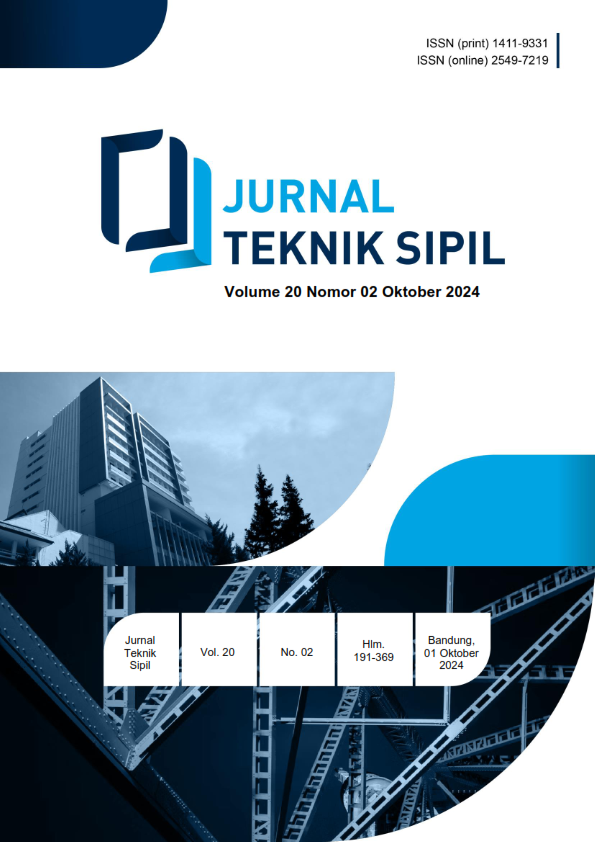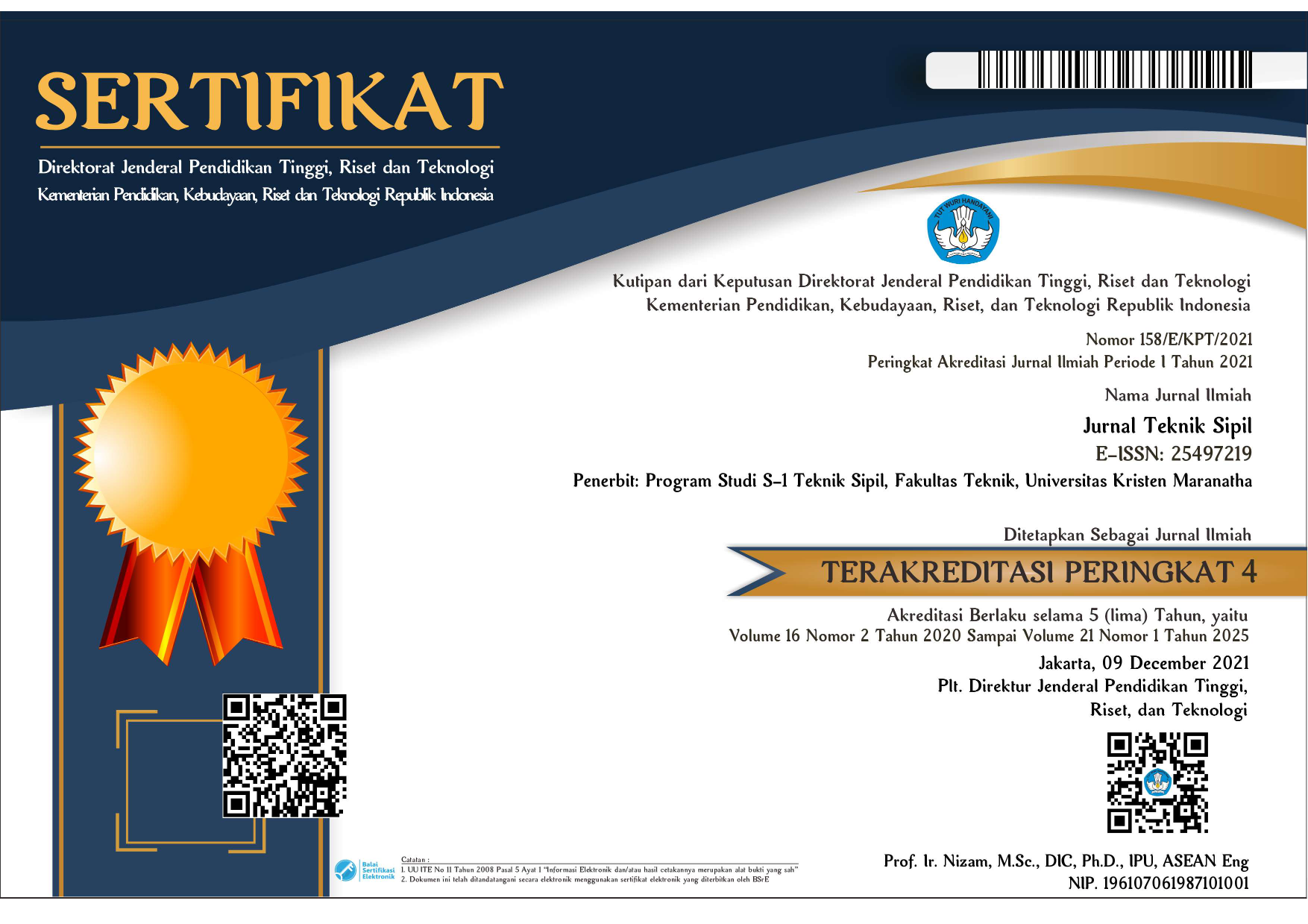Analysis Of Value Engineering for Architectural Work Cost Savings in The South Tangerang Apartment X Project
DOI:
https://doi.org/10.28932/jts.v20i2.6202Keywords:
Value Engineering Analysis, Apartment, TOPSISAbstract
The demand for housing among the population is substantial, leading to the challenge of insufficient land area for construction. We construct residential developments horizontally to address this issue. However, the construction costs associated with this approach are significantly higher. As a result, there is a need for various efforts to optimize construction costs, and one such initiative involves the application of value engineering methods. The X Apartment Project in South Tangerang, with a construction value of Rp. 203,204,569,971, is the focus of this study. Based on the significant value of the development, this study seeks to estimate cost savings through value engineering analysis, particularly in the area of architectural work. This research method has four stages, namely the information stage, the speculation stage, the analysis stage, and the presentation stage. The observations lasted one month and were conducted using a questionnaire instrument. The Technique for Order Preference by Similarity to Ideal Solution (TOPSIS) method provides an alternative decision-making system. This study demonstrates that the application of value engineering reduced the initial cost of Rp. 203,204,569,971 to Rp. 201,685,400,449, with a reduction of 0.75% in window work (J1), glass door work (PL1), door work (PD1), light brick wall work, and homogenous tile KR2B floor tile work.Downloads
References
Abdelfatah, S., Abdel-Hamid, M., & Ahmed, A. A. (2020). Applying value engineering technique using building information modeling at underground metro station. International Journal of Engineering Research and Technology, 13(7), 1555–1561. https://doi.org/10.37624/ijert/13.7.2020.1555-1561
Abdul, B., Abdul, K., & Radhi, K. (2020). The Importance of Production and Operations Management in the Application of Value Engineering Technology and its Role in Improving Product Quality ( An Applied Study in a Light Industry Company ). 14(1), 727–743.
Ahyar, H., Maret, U. S., Andriani, H., Sukmana, D. J., Mada, U. G., Hardani, S.Pd., M. S., Nur Hikmatul Auliya, G. C. B., Helmina Andriani, M. S., Fardani, R. A., Ustiawaty, J., Utami, E. F., Sukmana, D. J., & Istiqomah, R. R. (2020). Buku Metode Penelitian Kualitatif & Kuantitatif (Issue March).
Al-Gahtani, K. S. A. (2022). Review Current Value Engineering Studies Towards Improve Automation within Building Information Management (BIM). International Journal of Civil Engineering, 9(2), 1–9. https://doi.org/10.14445/23488352/ijce-v9i2p101
Arikunto, S. (2010). Prosedur Penelitian Suatu Pendekatan Praktik-Revisi Ke X. Rineka Cipta.
Bertolini, V. (2016). Aplikasi Value Engineering pada Proyek Pembangunan Gedung (Studi Kasus Hotel Grand Banjarmasin). Jurnal IPTEK, 20(2), 53. https://doi.org/10.31284/j.iptek.2016.v20i2.32
Brahmane, N. S., & Bachhav, S. S. (2020). Implementation of Value Engineering in Construction Project To Reduce Time of the Project. 7–9.
Choudhury, A. R., Kumar, R., Sahoo, A. K., Panda, A., & Malakar, A. (2020). Machinability investigation on novel incoloy 330 super alloy using coconut oil based SiO2 nano fluid. International Journal of Integrated Engineering, 12(4), 145–160.
Diputera, I. G. A., Agung, I. G., Putera, A., Putu, A., & Dharmayanti, C. (2018). Penerapan Value Engineering (Ve) Pada Proyek Pembangunan Taman Sari Apartement. Jurnal Spektran, 6(2), 210–216.
Direktorat Jenderal Bina Marga, S., Direktur di Direktorat Jenderal Bina Marga, P., Kepala Balai Besar, P., Pelaksanaan Jalan Nasional Di Direktorat Jenderal Bina Marga, B., & Kepala Satuan Kerja di Direktorat Jenderal Bina Marga, P. (2020). Direktorat Jenderal Bina Marga. 021, 7393938.
Ebubekir, P., This, A., Access, O., Commons, C., & International, A. (2022). Application of Value Engineering to Identify and Solve Irrigation Water Allocation Problems. 3, 430–441.
Fitri, R., & Pangaribowo, R. L. (2022). Analisis ketersediaan ruang terbuka hijau di Kota Tangerang Selatan. Jurnal Arsitektur Lansekap, 8(2), 119. https://doi.org/10.24843/jal.2022.v08.i02.p13
Hendrianto, G. K., Sugiyarto, S., & Setyawan, A. (2018). Analisis Value Engineering Untuk Efisiensi Biaya (Studi Kasus: Proyek Apartemen Yukata Suites Alam Sutera Tangerang). Matriks Teknik Sipil, 6(4), 646–651. https://doi.org/10.20961/mateksi.v6i4.36538
Irfanto, R., W, I. S. N., & Dermawan, H. (2023). Penerapan Konsep Value Engineering pada Proyek Bangunan Gedung Sekolah. Jurnal Teknik Sipil, 19(1), 98–111. https://doi.org/10.28932/jts.v19i1.5254
Katohardjono, S., Ali Berawi, M., -Jl Bungo Pasang Tabing, P., Padang, K., Barat, S., & Mengutip, C. (2021). Rekayasa Nilai Kriteria Desain Fasilitas Produksi Gas Alam (Design Criteria Value Engineering for Natural Gas Production Facilities) ARTICLE INFO ABSTRAK. Ju, 6(2), 120–134. https://doi.org/10.33366/rekabuana.v6i2.2642
Miladi Rad, K., & Aminoroayaie Yamini, O. (2016). The Methodology of Using Value Engineering in Construction Projects Management. Civil Engineering Journal, 2(6), 262. https://doi.org/10.28991/cej-030986
Nigjeh, M. J., & Amani, N. (2022). Evaluation of influential value engineering factors on the function of interchanges: case studies in Iran. Journal of Engineering and Applied Science, 69(1), 1–15. https://doi.org/10.1186/s44147-022-00100-9
Parida, A. K., & Routara, B. C. (2014). Multiresponse Optimization of Process Parameters in Turning of GFRP Using TOPSIS Method. International Scholarly Research Notices, 2014, 1–10. https://doi.org/10.1155/2014/905828
Senay, A., & Niyazi, G. (2013). Application of Value Engineering in Construction Projects. Journal of Traffic and Transportation Engineering, 1(1), 39–48.
Setiawan, D., & Kristianto Marbun, M. (2021). Kajian Indikator Material Mechanical, Electrical, dan Plumbing Ramah Lingkungan. Jurnal Teknik Sipil, 17(2), 145–157.
Tenepalli JaiSai, Devleen Mandal, & Manas Upadhyay. (2022). Implementing Value Engineering for Structural Works During the Design Phase for a Residential Project. EPRA International Journal of Multidisciplinary Research (IJMR), March, 91–96. https://doi.org/10.36713/epra9708
Downloads
Published
How to Cite
Issue
Section
License
Copyright (c) 2024 Muhammad Mahesa Ramadhan, Marisa Wahyu Kurniasari

This work is licensed under a Creative Commons Attribution-NonCommercial 4.0 International License.
























